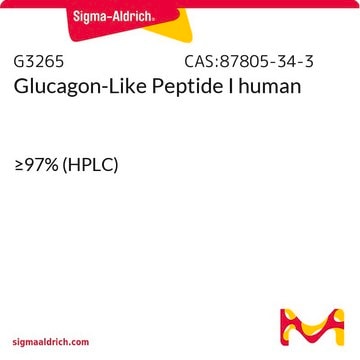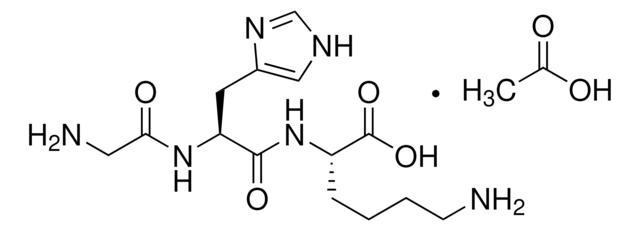Selecione um tamanho
Selecione um tamanho
About This Item
Produtos recomendados
Ensaio
≥97% (HPLC)
Formulário
powder
temperatura de armazenamento
−20°C
cadeia de caracteres SMILES
CC(C)C[C@H](NC(=O)CNC(=O)[C@H](CCC(N)=O)NC(=O)[C@H](CC(C)C)NC(=O)[C@H](CC(C)C)NC(=O)[C@H](CCCNC(N)=N)NC(=O)[C@H](CCC(N)=O)NC(=O)[C@H](CC(C)C)NC(=O)[C@H](CCCNC(N)=N)NC(=O)[C@H](C)NC(=O)CNC(=O)[C@H](CCC(O)=O)NC(=O)[C@H](CCCNC(N)=N)NC(=O)[C@H](CC(C)C)NC(=O)[C@H](CCCNC(N)=N)NC(=O)[C@H](CO)NC(=O)[C@H](CC(C)C)NC(=O)[C@H](CCC(O)=O)NC(=O)[C@H](CO)NC(=O)[C@@H](NC(=O)[C@H](Cc1ccccc1)NC(=O)[C@@H](NC(=O)CNC(=O)[C@H](CC(O)=O)NC(=O)[C@H](CO)NC(=O)[C@@H](N)Cc2c[nH]cn2)[C@@H](C)O)[C@@H](C)O)C(=O)N[C@@H](C(C)C)C(N)=O
InChI
1S/C130H220N44O40/c1-60(2)43-81(120(208)173-100(66(13)14)103(134)191)153-95(183)54-149-106(194)77(31-35-92(132)180)159-116(204)84(46-63(7)8)166-118(206)85(47-64(9)10)164-111(199)75(29-23-41-146-129(139)140)155-113(201)79(32-36-93(133)181)160-117(205)83(45-62(5)6)162-110(198)73(27-21-39-144-127(135)136)154-104(192)67(15)152-94(182)53-148-107(195)78(33-37-97(185)186)158-109(197)74(28-22-40-145-128(137)138)156-115(203)82(44-61(3)4)163-112(200)76(30-24-42-147-130(141)142)157-122(210)90(57-176)170-119(207)86(48-65(11)12)165-114(202)80(34-38-98(187)188)161-123(211)91(58-177)171-126(214)102(69(17)179)174-121(209)87(49-70-25-19-18-20-26-70)168-125(213)101(68(16)178)172-96(184)55-150-108(196)88(51-99(189)190)167-124(212)89(56-175)169-105(193)72(131)50-71-52-143-59-151-71/h18-20,25-26,52,59-69,72-91,100-102,175-179H,21-24,27-51,53-58,131H2,1-17H3,(H2,132,180)(H2,133,181)(H2,134,191)(H,143,151)(H,148,195)(H,149,194)(H,150,196)(H,152,182)(H,153,183)(H,154,192)(H,155,201)(H,156,203)(H,157,210)(H,158,197)(H,159,204)(H,160,205)(H,161,211)(H,162,198)(H,163,200)(H,164,199)(H,165,202)(H,166,206)(H,167,212)(H,168,213)(H,169,193)(H,170,207)(H,171,214)(H,172,184)(H,173,208)(H,174,209)(H,185,186)(H,187,188)(H,189,190)(H4,135,136,144)(H4,137,138,145)(H4,139,140,146)(H4,141,142,147)/t67-,68+,69+,72-,73-,74-,75-,76-,77-,78-,79-,80-,81-,82-,83-,84-,85-,86-,87-,88-,89-,90-,91-,100-,101-,102-/m0/s1
chave InChI
OWMZNFCDEHGFEP-NFBCVYDUSA-N
Informações sobre genes
human ... SCT(6343) , SCTR(6344)
Categorias relacionadas
Amino Acid Sequence
Descrição geral
Aplicação
- in the radioimmunoassay with oxyntomodulin[3]
- to test its effect on the enlargement and swelling of human endoderm stem cells (hEnSCs) derived cyst[4]
- to stimulate human induced pluripotent stem cells (iPSC)-derived biliary cells in cyclic adenosine monophosphate (cAMP) assays to test its effect on cAMP production[5]
Ações bioquímicas/fisiológicas
Código de classe de armazenamento
11 - Combustible Solids
Classe de risco de água (WGK)
WGK 3
Ponto de fulgor (°F)
Not applicable
Ponto de fulgor (°C)
Not applicable
Equipamento de proteção individual
Eyeshields, Gloves, type N95 (US)
Escolha uma das versões mais recentes:
Certificados de análise (COA)
Não está vendo a versão correta?
Se precisar de uma versão específica, você pode procurar um certificado específico pelo número do lote ou da remessa.
Já possui este produto?
Encontre a documentação dos produtos que você adquiriu recentemente na biblioteca de documentos.
Active Filters
Nossa equipe de cientistas tem experiência em todas as áreas de pesquisa, incluindo Life Sciences, ciência de materiais, síntese química, cromatografia, química analítica e muitas outras.
Entre em contato com a assistência técnica








